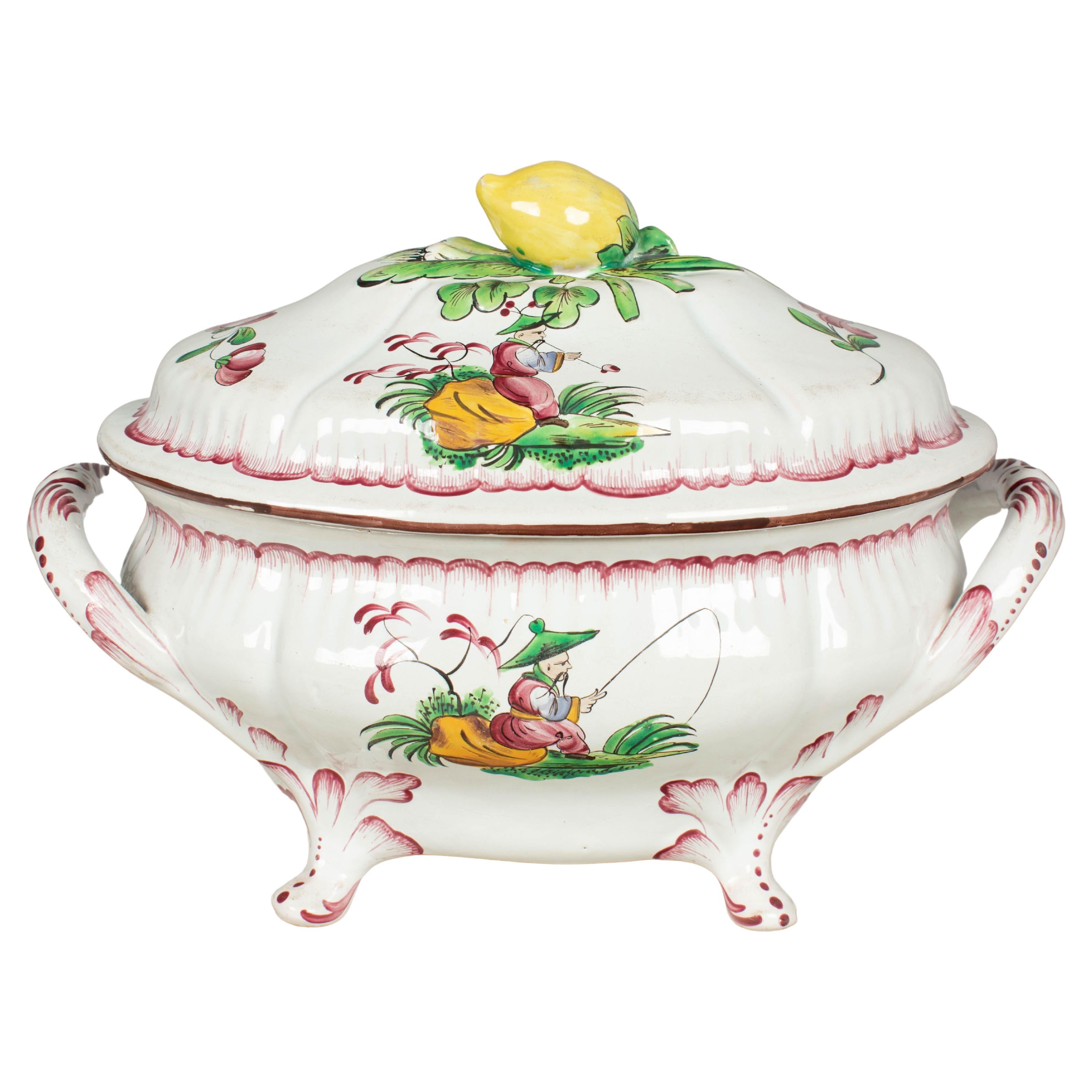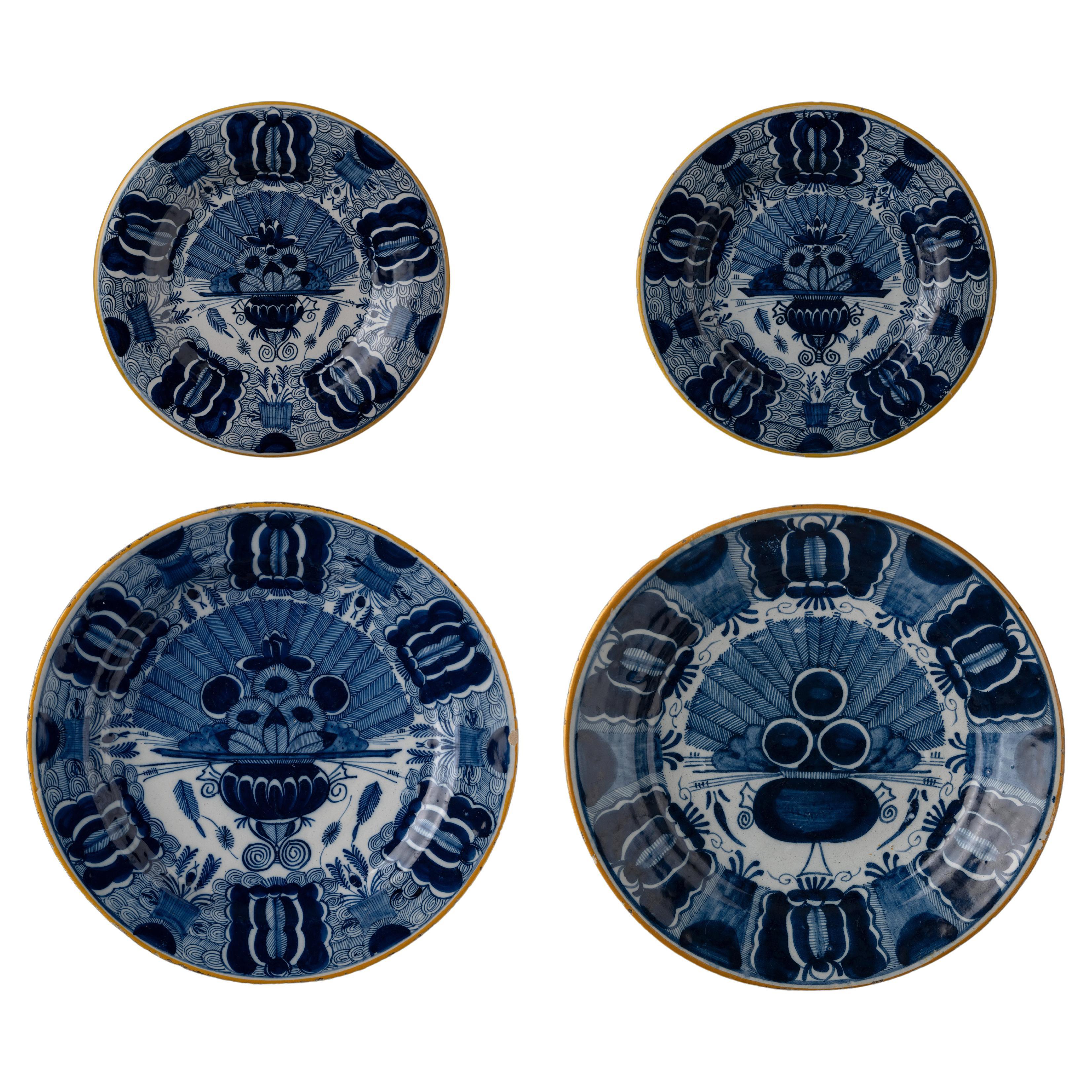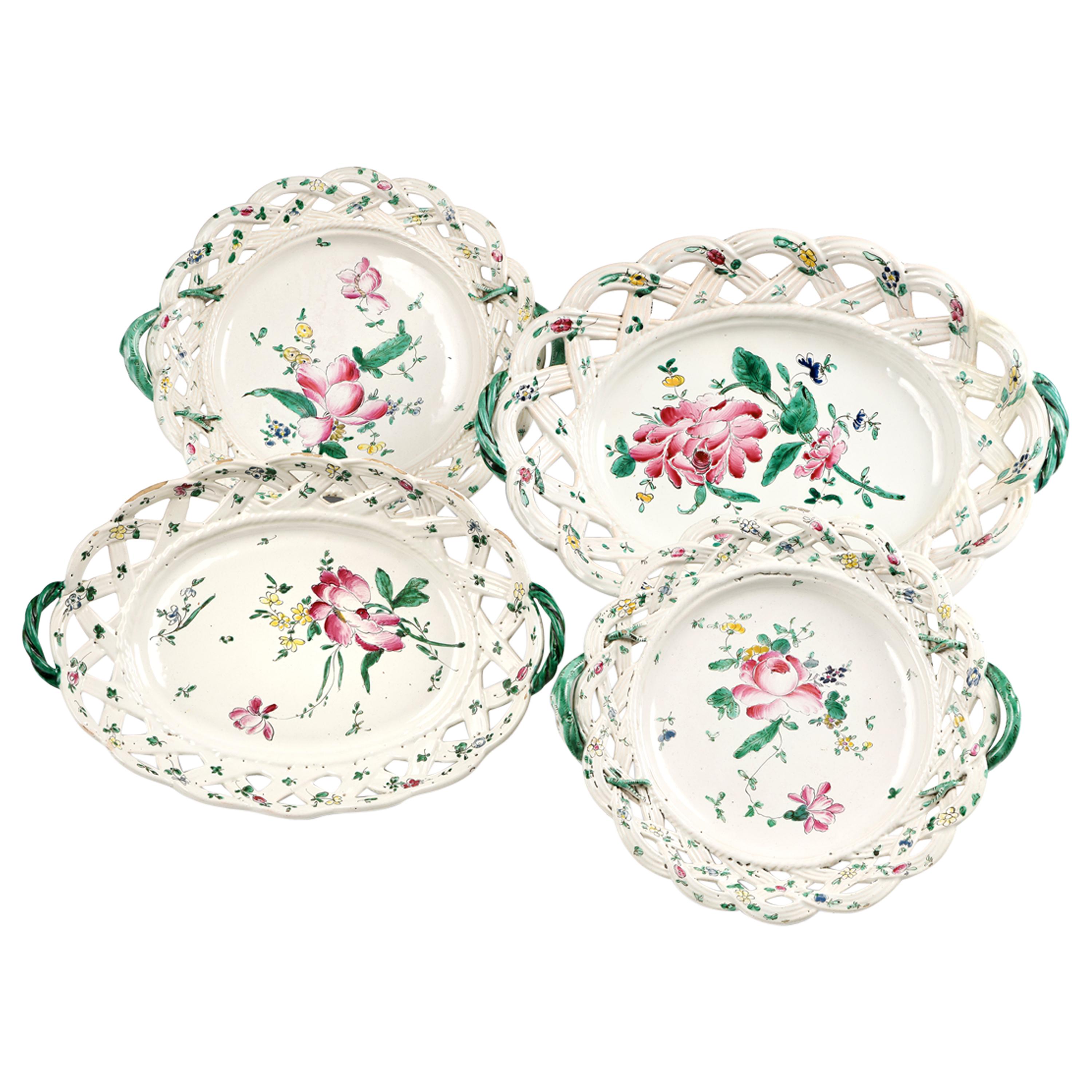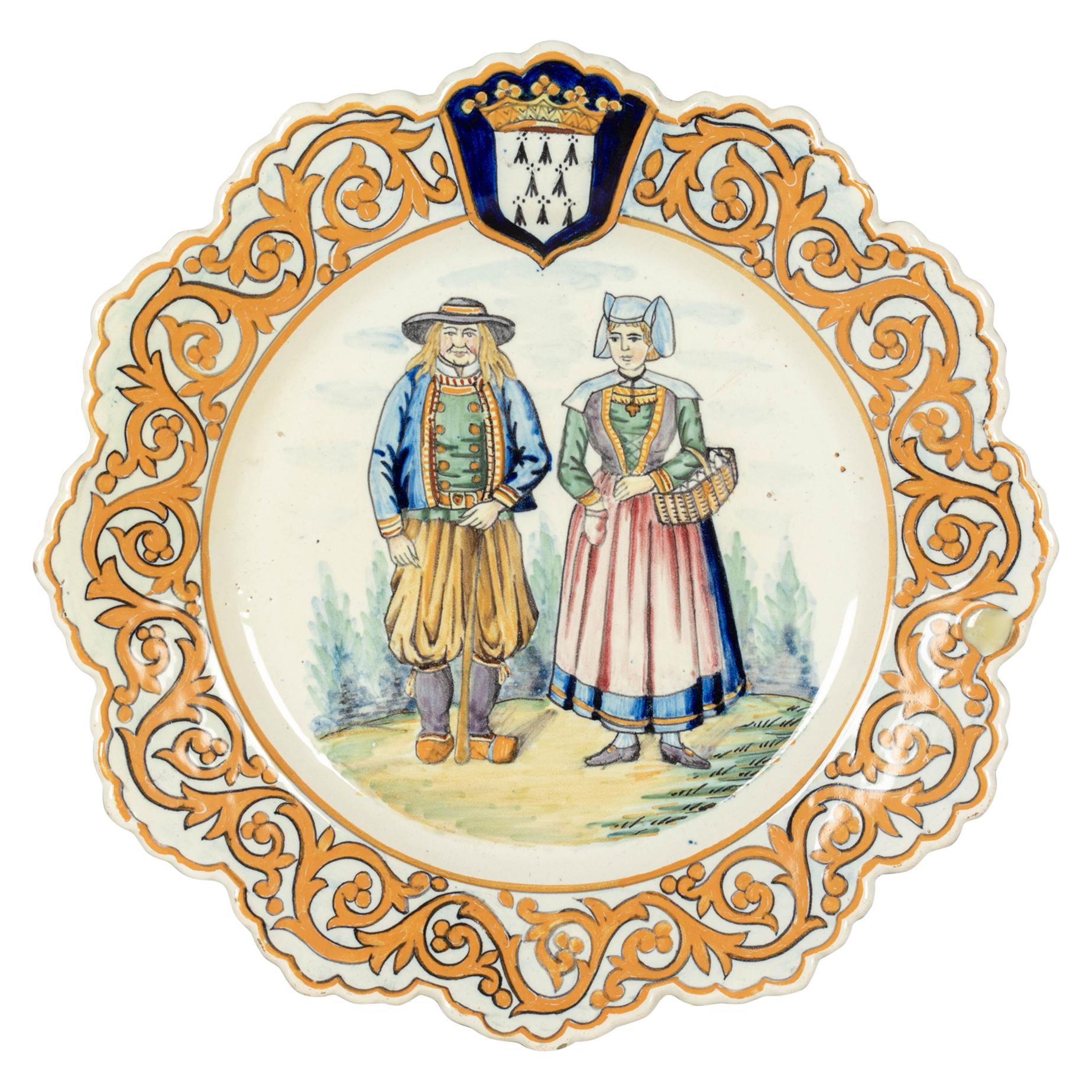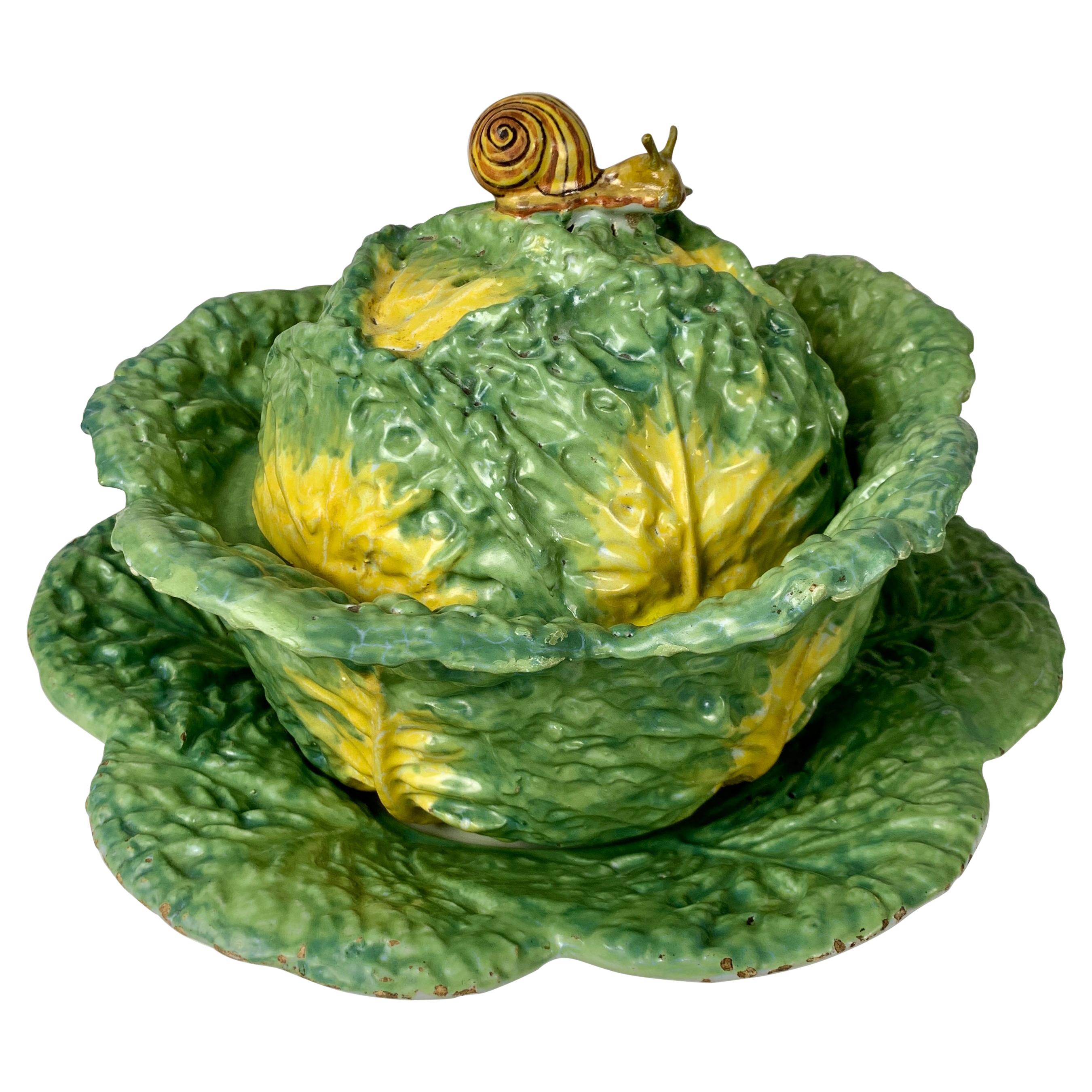Items Similar to Vintage Italian Hand Painted Faience Soup Dishes
Want more images or videos?
Request additional images or videos from the seller
1 of 6
Vintage Italian Hand Painted Faience Soup Dishes
About the Item
This is superb set of 12 faience "Vietri" Italy Hand Painted Soup plates. The plates were painted and signed by Romolo Apicella. We believe that the plates date to the 1960's, but it is difficult to ascertain their precise date of creation. The plates feature citrons (lemons) or quinces with wisteria blossoms and foliage on an ivory background and are further enhanced by a lavender rim. These dishes would provide a wonderful accent to a Hampton's kitchen or outdoor dining.
- Dimensions:Height: 2 in (5.08 cm)Diameter: 9.25 in (23.5 cm)
- Sold As:Set of 11
- Style:Bohemian (In the Style Of)
- Materials and Techniques:
- Place of Origin:
- Period:
- Date of Manufacture:c. 1960
- Condition:No faults were noted--hints of use and tiny bit of patina.
- Seller Location:Pasadena, CA
- Reference Number:
About the Seller
5.0
Gold Seller
These expertly vetted sellers are highly rated and consistently exceed customer expectations.
Established in 1993
1stDibs seller since 2017
224 sales on 1stDibs
Typical response time: <1 hour
- ShippingRetrieving quote...Ships From: Pasadena, CA
- Return PolicyA return for this item may be initiated within 2 days of delivery.
More From This SellerView All
- Italian Faience Side/Salad PlatesLocated in Pasadena, CAThis is superb set of 10 faience "Vietri" Italy hand painted side or salad plates. The plates were painted and signed by Romolo Apicella. We believe that ...Category
Mid-20th Century Italian Bohemian Delft and Faience
MaterialsFaience, Majolica
- 18th Century Delft Chinoiserie ChargerLocated in Pasadena, CAThis is a good example of a mid-18th century Delft charger in a chinoiserie hand-painted pattern. The pottery is hand-painted in a traditional blue and white chinoiserie scene featur...Category
Antique Mid-18th Century Dutch Chinoiserie Delft and Faience
MaterialsFaience
- Large Glazed Tang-Style Terracotta EwerLocated in Pasadena, CAThis is a stunning large Chinese glazed terracotta dragon-form ewer. The Double Dragons are cast in fine detail. The ewer derives its inspiration fro...Category
Antique Late 19th Century Chinese Chinese Export Delft and Faience
MaterialsTerracotta
- Early 19th Century Pearlware Chestnut BasketLocated in Pasadena, CAThis is a good example of a very early 19th century Pearlware Chestnut Basket in the "Blue Willow" transfer pattern. Creamware was invented during the second half of the 18th century and reached its height of popularity c.1810. Chestnut baskets were common serving pieces in 18th and 19th century households. Period antique Chestnut basket...Category
Antique Early 19th Century English Regency Ceramics
MaterialsClay
- Pair Painted Tole Beds, Late 19th c.Located in Pasadena, CAThis is a superb pair of painted tole single beds that dates to the late 19th century to circa 1920. The beds feature a butter yellow base color with a painted landscape to both the ...Category
Antique Early 1900s Italian Belle Époque Beds and Bed Frames
MaterialsMetal
- Italian Beaded SconceLocated in Pasadena, CAThis is a charming single Maria Teresa-style Italian beaded sconce that dates to the 1950s. The sconce is detailed with an abundance of faceted d...Category
Mid-20th Century Italian Hollywood Regency Wall Lights and Sconces
MaterialsBrass, Gold Leaf
You May Also Like
- French Hand-Painted Faience Soup TureenLocated in Winter Park, FLAn early 20th century French faience footed oval tureen with traditional design typical of Eastern France. Hand-painted Chinoiserie decoration in pink, ora...Category
Early 20th Century French Country Delft and Faience
MaterialsFaience
- 19th Century French Hand Painted Oval Faience Wall Platter from RouenBy RouenLocated in Dallas, TXThis beautiful antique ceramic dish was crafted in Normandy, France, circa 1880. The stylized ceramic plate has a scalloped edge and depicts a han...Category
Antique Late 19th Century French Delft and Faience
MaterialsFaience
- Set of 4 Delft Plates and Dishes Hand-Painted with "Peacock" Pattern 1750-1800By Dutch OriginalsLocated in Verviers, BEA set of two peacock design Delft plates, and two larger Delft dishes. All hand-painted with "peacock" pattern. 2 plates marked "De Porceleyne Claeuw" Dimensions: diameter of 9" / 23cm each plate. 2 dishes are also marked, one for "De Porceleyne Claeuw" (Porcelain Claw) and the other one marked 'De drie...Category
Antique Late 18th Century Dutch Baroque Ceramics
MaterialsCeramic, Delft, Faience
- Four Italian Ancient Dishes, Lodi, circa 1770-1780By Antonio FerrettiLocated in Milano, ITAssortment of 4 dishes with braided rim Antonio Ferretti Manufacture Lodi, circa 1770-1780 Maiolica polychrome decorated “a piccolo fuoco” (third fire). Measures: 14 x 10 in (35.5 x 25.5 cm); 12.2 x 8.39 in (31 x 21.3 cm); 10.4 x 9.65 in (26.5 x 24.5 cm); 10.8 x 9.61 in (27.5 x 24.4 cm). Weight: 4.4 lb (1.998 kg) State of conservation: some chips due to use on the edges and on the parts in relief. The four different dishes have a foot with a low lip from which extends a wide, flat, slanted rim resembling a basket weave. The small handles are painted green: they resemble wickerwork in the two oval dishes and take the form of a sinuous branch in the round ones. The third fire decoration is inspired by the naturalistic floral botanical patterns on the ceramics produced by the Hannong family in Strasbourg. Here the pattern is defined by the rapidity and subtlety of the brushstrokes and the result is particularly tasteful, characterized by compositional intelligence and pictorial expertise. A main corolla, either a wild or garden rose, is set slightly off center in each well. From this extends a thin stem holding a small secondary bud and there are small field florets dotting the composition to lend volume to the delicate bunch of flowers. On the brim, small polychrome flowers add color to the weave, accompanied by lanceolate leaves of a very intense green. There exist few and very rare examples for comparison with this morphology: a round plate - entirely consistent with those in question - has been dated to around 1775 (S. Levy, Maioliche settecentesche lombarde e venete, Milano 1962, tav. 200). Two other dishes with a basket rim, but with parallel striped brim decoration, were exhibited in the 1995 exhibition on Lodi ceramics; the attribution to the Lombard town near Milan is therefore almost exclusively derived from the decoration called "alla rosa contornata" or "alla vecchia Lodi" and constitutes one of the most popular decorations during the eighteenth century. (M. L. Gelmini, in Maioliche lodigiane del '700 (cat. mostra Lodi), Milano 1995, pp. 31 p. 162-163 nn. 181-182). This decorative choice represented a strong point of the Lodi factory, which established itself thanks to the vivid nature of the colors made possible by the introduction of a new technique perfected by Paul Hannong in Strasbourg and which Antonio Ferretti introduced in Italy. This production process, called “piccolo fuoco” (third fire), allowed the use of a greater number of colors than in the past; in particular, the purple of Cassius, a red made from gold chloride, was introduced. Its use allowed for many more tones and shades, from pink to purple. The Ferretti family had started their Maiolica manufacturing business in Lodi in 1725. The forefather Simpliciano had started the business by purchasing an ancient furnace in 1725 and, indeed, we have evidence of the full activity of the furnaces from April of the same year (Novasconi-Ferrari-Corvi, 1964, p. 26 n. 4). Simpliciano had started a production of excellence also thanks to the ownership of clay quarries in Stradella, not far from Pavia. The production was so successful that in 1726 a decree of the Turin Chamber came to prohibit the importation of foreign ceramics, especially from Lodi, to protect internal production (G. Lise, La ceramica a Lodi, Lodi 1981, p. 59). In its initial stages, the manufacture produced maolicas painted with the “a gran fuoco” (double fire) technique, often in turquoise monochrome, with ornamentation derived from compositional modules in vogue in Rouen in France. This was also thanks to the collaboration of painters like Giorgio Giacinto Rossetti, who placed his name on the best specimens next to the initials of the factory. In 1748 Simpliciano made his will (Gelmini, 1995, p. 30) appointing his son Giuseppe Antonio (known as Antonio) as universal heir. After 1750, when Simpliciano passed away, Antonio was directly involved in the Maiolica factory, increasing its fortunes and achieving a reputation on a European level. Particularly important was the aforementioned introduction in 1760 of the innovative “a piccolo fuoco” (third fire) processing, which, expanding the ornamental repertoire with Saxon-inspired floral themes, could commercially compete with the German porcelains that had one of its most renowned offerings in the naturalistic Deutsche Blumen. Antonio Ferretti understood and promoted this technique and this decoration, proposing it in a fresher and more corrective version, less linked to botanical tables...Category
Antique 1770s Italian Neoclassical Ceramics
MaterialsMaiolica
- French Henriot Quimper Faience PlateBy Henriot QuimperLocated in Winter Park, FLA Henriot Quimper French faience hand painted decorative plate, depicting a Breton couple in traditional clothing. Orange foliate border and with Quimper crown crest at the top. A go...Category
Early 20th Century French Delft and Faience
MaterialsFaience
- Antique Faience Cabbage Form Soup Tureen Hand-Painted in Brussels Circa 1765Located in Katonah, NYThis faience soup tureen was made in the Philippe Mombaers factory in Brussels circa 1765. The cabbage tureen, its cover, and the stand are painted in ...Category
Antique Mid-18th Century Belgian Rococo Delft and Faience
MaterialsFaience
Recently Viewed
View AllMore Ways To Browse
Retro Hand Painted Glass
Vintage Painted Glass
Vintage Hand Painted Glasses
Vintage Painted Plates
Soup Plates 12
Italian Kitchen Accents
Vintage Hand Painted Plate Italy
Soup Italy
Vintage Delft Delft
Vintage Lemons
Outdoor Kitchen
Set Of Vintage Italian Plates
Italian Mid Century Outdoor
Italian Outdoor Set
Lavender Glass Vintage
Delft Sign
Vintage Hamptons
Vintage Glass Dishes
